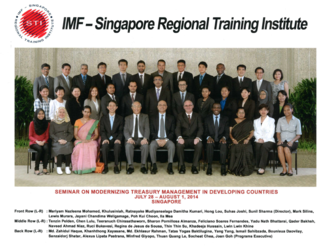
Posted by Lewis Murara, Suhas Joshi and Mark Silins1
For one fully packed week, thirty-one participants from twenty Asian countries recently participated in a course at the IMF’s Singapore Regional Training Institute (STI) to discuss how to modernize treasury management in their countries, drawing from international experience . This course evolved from earlier courses, presented at the STI over the last three years, on the sequencing of PFM reforms. It was decided that a more focused and targeted course on treasury management would add most value. The present course was designed to dovetail neatly with technical assistance provided by the IMF’s Fiscal Affairs Department (FAD) in the region.
Participants included mid- to high-level officials from ministries of finance and central banks. The countries represented were a cross-section of high, middle and low income countries. Because the participants came from countries with significantly different levels of PFM development and with varying degrees of familiarity with PFM issues, the course offered both challenges and opportunities. On the one hand, it was a challenge to pitch the course materials at a level that met the experience and knowledge of all participants. On the other hand, the variety of country experiences proved to be a great learning opportunity for each participant.
The seminar covered a wide array of topics such as the relationship between treasury management and the PFM Framework, the Treasury Single Account (TSA), integrated treasury and cash management systems, the role and importance of treasury management and the chart of accounts, development of an integrated cash flow management framework, treasury and cash management in a computerized environment, strategic evolution of the treasury function, cash versus accrual reporting, treasury management and the control of budget execution, and challenges of (and responses to) financing fiscal deficits.
Among country examples discussed, the participants had the opportunity to learn in detail about the experience of treasury reforms in China, presented by the Deputy Director General of the Chinese Treasury Mr. LOU Hong. This presentation focused on the conceptual design of the TSA in China and the role of People’s Bank of China and other banks in providing banking services, particularly zero-balanced accounts for budget entities across the five levels of government that exist in China. It also touched on issues of TSA implementation strategy in China, IT systems and their use in budget management.
Individually or in groups, all participants reflected on how to apply the lessons learnt in their own countries and prepared and presented their treasury modernization action plans. They also had the opportunity to simulate and present a cash flow forecasting model for their own countries.
Overall, the feedback obtained from participants indicated positive appreciation of the course, its content and presentation. The main issues highlighted by the participants were the need to make the course longer than one week, and to include more country case studies and more workshop sessions. The presentation of Chinese experience with TSA implementation was especially appreciated. Another highlight of the seminar was the participants’ reflection on and presentation of their own treasury modernization plans. Participants suggested that future seminars should include more short presentations by the countries on their own experiences.
Finally, a few lessons from this seminar:
• Reforming treasury management is more an institutional reform than a technical exercise;
• There is no one-size-fits-all formula to treasury modernization; reforms cannot be linear and uniform, but instead should be organic and reflect the context of each country;
• Treasury modernization reform cannot be done in isolation; it has ramifications for reforms in other parts of the public sector;
• Countries that got it right (or are getting it right) have planned ahead, and stayed the course;
• When institutional or political changes happen (as they always will), plans for modernizing the treasury need to be flexible so as to accommodate the required adjustments.
Stay tuned for the next IMF treasury modernization seminar in Singapore!
1Lewis Murara is a PFM TA Advisor in FAD, Suhas Joshi is FAD’s Regional PFM Advisor in Asia, and Mark Silins is FAD’s PFM short-term expert.
2The course took place from July 28 to August 1, 2014.
Note: The posts on the IMF PFM Blog should not be reported as representing the views of the IMF. The views expressed are those of the authors and do not necessarily represent those of the IMF or IMF policy.







